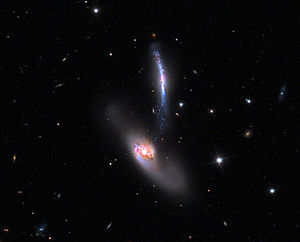NGC 2799
| Galaxy NGC 2799 |
|
|---|---|

|
|
| The galaxies NGC 2799 (above) and NGC 2798 (below), recorded with the 81 cm reflecting telescope of the Mount Lemmon Observatory . | |
| AladinLite | |
| Constellation | lynx |
|
Position equinox : J2000.0 , epoch : J2000.0 |
|
| Right ascension | 09 h 17 m 31.0 s |
| declination | + 41 ° 59 ′ 39 ″ |
| Appearance | |
| Morphological type | SB (s) m? / HII |
| Brightness (visual) | 13.7 mag |
| Brightness (B-band) | 14.3 mag |
| Angular expansion | 1.9 ′ × 0.5 ′ |
| Position angle | 125 ° |
| Surface brightness | 13.5 mag / arcmin² |
| Physical data | |
| Redshift | 0.005581 +/- 0.000013 |
| Radial velocity | 1673 +/- 4 km / s |
|
Stroke distance v rad / H 0 |
(75 ± 5) x 10 6 ly (22.9 ± 1.6) Mpc |
| history | |
| discovery | Ralph Copeland |
| Discovery date | March 9, 1874 |
| Catalog names | |
| NGC 2799 • UGC 4909 • PGC 26238 • CGCG 209-046 • MCG + 07-19-056 • KUG 0914 + 422B • Arp 283 • VV 50 • KCPG 195B | |
NGC 2799 is a barred spiral galaxy of the Hubble type SB (s) m? in the constellation lynx in the northern sky , which is an estimated 75 million light years away from the Milky Way . It forms an interactive pair with NGC 2798 , which was listed as Arp 283 . Halton Arp organized his catalog of unusual galaxies into groups according to purely morphological criteria. This galaxy pair belongs to the class double galaxies with inflow and attraction .
The object was discovered on March 9, 1874 by astronomer Ralph Copeland using the 72-inch Leviathan mirror telescope.
Web links
literature
- Jeff Kanipe and Dennis Webb: The Arp Atlas of Peculiar Galaxies - A Chronicle and Observer's Guide " , Richmond 2006, ISBN 978-0-943396-76-7
